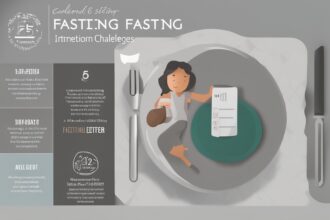Hey there, fellow health enthusiasts! If you’ve ever considered fasting as a way to boost your wellness, you’ve likely heard about the incredible fasting benefits—from weight loss to improved mental clarity. But let’s be real: fasting isn’t always a walk in the park. Whether you’re a newbie trying intermittent fasting or a seasoned pro tackling extended fasts, challenges like hunger pangs, social pressures, and energy dips can test your resolve. In this post, we’re diving deep into the most common fasting challenges and sharing actionable strategies to overcome them. Backed by science and sprinkled with personal insights, this guide will help you navigate the ups and downs of fasting so you can fully reap the rewards of this transformative practice.
What Are the Core Fasting Benefits Worth Striving For?
Before we tackle the hurdles, let’s remind ourselves why fasting is worth the effort. The fasting benefits are well-documented and span both physical and mental health. Research shows that fasting can promote weight loss by reducing calorie intake and enhancing fat-burning through a process called ketosis (Mattson et al., 2017). It also improves insulin sensitivity, which is crucial for managing blood sugar levels and reducing the risk of type 2 diabetes (Barnard et al., 2019). Beyond the body, fasting has been linked to better brain health, with studies suggesting it may enhance cognitive function and protect against neurodegenerative diseases (Mattson, 2019). These perks make overcoming fasting obstacles a goal worth pursuing, don’t you think?
Challenge 1: Battling Hunger and Cravings
Let’s start with the most obvious struggle: hunger. When you first begin fasting, your stomach might growl louder than a bear, and cravings for that chocolate bar can feel relentless. This happens because your body is used to regular meals, and fasting disrupts your usual ghrelin (hunger hormone) patterns (Cummings et al., 2002). The good news? Your body adapts over time. Until then, here are some practical ways to manage those hunger pangs and stay committed to unlocking the health benefits of fasting.
- Stay Hydrated: Drinking plenty of water can trick your stomach into feeling fuller and reduce hunger signals. Add a splash of lemon for flavor if plain water feels boring.
- Distract Yourself: Keep busy with a hobby or light exercise—hunger often fades when your mind is occupied.
- Ease Into It: If you’re new, start with shorter fasting windows like 12:12 (12 hours fasting, 12 hours eating) before jumping into 16:8 or longer fasts.
- Focus on Nutrient-Dense Meals: When you do eat, prioritize protein, fiber, and healthy fats to keep you satiated longer during fasting periods.
Challenge 2: Navigating Social and Family Pressures
Picture this: you’re in the middle of a 24-hour fast, and your friends invite you to a pizza night. Or maybe your family insists on a big Sunday brunch. Social situations can be a real test when you’re fasting, especially since food is often at the center of bonding. Saying “no” without feeling like a party pooper is tricky, but it’s doable. The key is communication and planning. Explain your goals—maybe even share how the fasting benefits have improved your energy or focus. Most people will respect your commitment. Also, try scheduling your eating windows around social events when possible. If that’s not an option, bring a fasting-friendly drink like herbal tea to sip on while you chat. It’s all about balance and not letting fasting isolate you from loved ones.
Challenge 3: Dealing with Fatigue and Low Energy
Feeling sluggish during a fast is common, especially in the early stages. This often stems from your body adjusting to lower glucose levels as it switches to burning stored fat for fuel (Anton et al., 2018). While this metabolic shift is one of the intermittent fasting benefits, it can leave you dragging through the day at first. To combat this, ensure you’re getting enough electrolytes—sodium, potassium, and magnesium—by adding a pinch of salt to your water or eating nutrient-rich foods during eating windows. Rest is also crucial; don’t skimp on sleep, as it supports your body’s adaptation to fasting. If fatigue persists beyond a couple of weeks, consult a healthcare provider to rule out underlying issues like nutrient deficiencies.
Challenge 4: Breaking Through Mental Barriers
Fasting isn’t just a physical challenge; it’s a mental game too. Doubts like “Can I really do this?” or “Is this even worth it?” can creep in, especially on tough days. Building mental resilience is key to sticking with fasting and enjoying its long-term fasting benefits. Start by setting realistic goals—don’t aim for a 5-day water fast if you’ve never fasted before. Celebrate small wins, like completing your first 16-hour fast, to keep motivation high. Some people find mindfulness practices like meditation helpful for managing stress and staying focused on their “why” behind fasting. Remember, your mindset can make or break your fasting journey.
- Track Your Progress: Use a journal or app to log how you feel each day—seeing improvements in energy or mood can be a huge motivator.
- Join a Community: Connect with others who fast, whether online or in person, to share tips and encouragement.
- Remind Yourself of the Science: Revisit studies or articles about fasting benefits to reinforce why you started.
Challenge 5: Avoiding Overeating After a Fast
One sneaky trap many fasters fall into is overeating once the fasting window ends. It’s tempting to “reward” yourself with a huge meal, but this can undo some of the fasting health benefits like calorie control and improved digestion. Overeating can also cause bloating or discomfort, making you dread the next fast. To avoid this, break your fast with a small, balanced meal—think a handful of nuts, a piece of fruit, or a light soup. This eases your digestive system back into action. Also, eat slowly and stop when you’re about 80% full; it takes time for your brain to register satiety (Rolls et al., 2000). Planning your post-fast meal ahead of time can prevent impulsive binges and keep you on track.
Challenge 6: Knowing When to Stop or Adjust
While fasting offers numerous benefits, it’s not a one-size-fits-all solution. Listening to your body is critical. If you experience severe dizziness, headaches, or irritability that doesn’t improve after a few days, it might be a sign to adjust your approach or take a break. Fasting isn’t recommended for everyone—pregnant women, individuals with certain medical conditions, or those with a history of eating disorders should avoid it unless under medical supervision (Johnstone, 2015). The goal is to enhance your health, not harm it. If you’re unsure, consult a doctor or dietitian to tailor fasting to your needs and ensure you’re still getting the fasting benefits safely.
As we wrap up, remember that fasting challenges are just stepping stones on the path to a healthier you. Whether it’s mastering hunger, dodging social temptations, or pushing through mental blocks, each obstacle you overcome brings you closer to the amazing fasting benefits—better metabolic health, sharper focus, and sustainable weight management. Take it one day at a time, be kind to yourself, and don’t hesitate to tweak your approach as needed. fasting is a personal journey, and with the right strategies, you’ve got this! Have you faced any unique fasting challenges? Drop a comment below—I’d love to hear your story and share more tips to support your goals.
References
- Anton, S. D., Moehl, K., Donahoo, W. T., Marosi, K., Lee, S. A., Mainous, A. G., … & Mattson, M. P. (2018). Flipping the metabolic switch: Understanding and applying the health benefits of fasting. Obesity, 26(2), 254-268. https://doi.org/10.1002/oby.22065
- Barnard, N. D., Levin, S. M., & Yokoyama, Y. (2019). A systematic review and meta-analysis of changes in body weight in clinical trials of vegetarian diets. Journal of the Academy of Nutrition and Dietetics, 119(6), 954-966. https://doi.org/10.1016/j.jand.2019.01.013
- Cummings, D. E., Purnell, J. Q., Frayo, R. S., Schmidova, K., Wisse, B. E., & Weigle, D. S. (2002). A preprandial rise in plasma ghrelin levels suggests a role in meal initiation in humans. Diabetes, 51(8), 2491-2494. https://doi.org/10.2337/diabetes.51.8.2491
- Johnstone, A. (2015). Fasting for weight loss: An effective strategy or latest dieting trend? International Journal of Obesity, 39(5), 727-733. https://doi.org/10.1038/ijo.2014.214
- Mattson, M. P. (2019). Effects of intermittent fasting on health, aging, and disease. New England Journal of Medicine, 381(26), 2541-2551. https://doi.org/10.1056/NEJMra1905136
- Mattson, M. P., Longo, V. D., & Harvie, M. (2017). Impact of intermittent fasting on health and disease processes. Ageing Research Reviews, 39, 46-58. https://doi.org/10.1016/j.arr.2016.10.005
- Rolls, B. J., Bell, E. A., & Waugh, B. A. (2000). Increasing the volume of a food by incorporating air affects satiety in men. American Journal of Clinical Nutrition, 72(2), 361-368. https://doi.org/10.1093/ajcn/72.2.361






